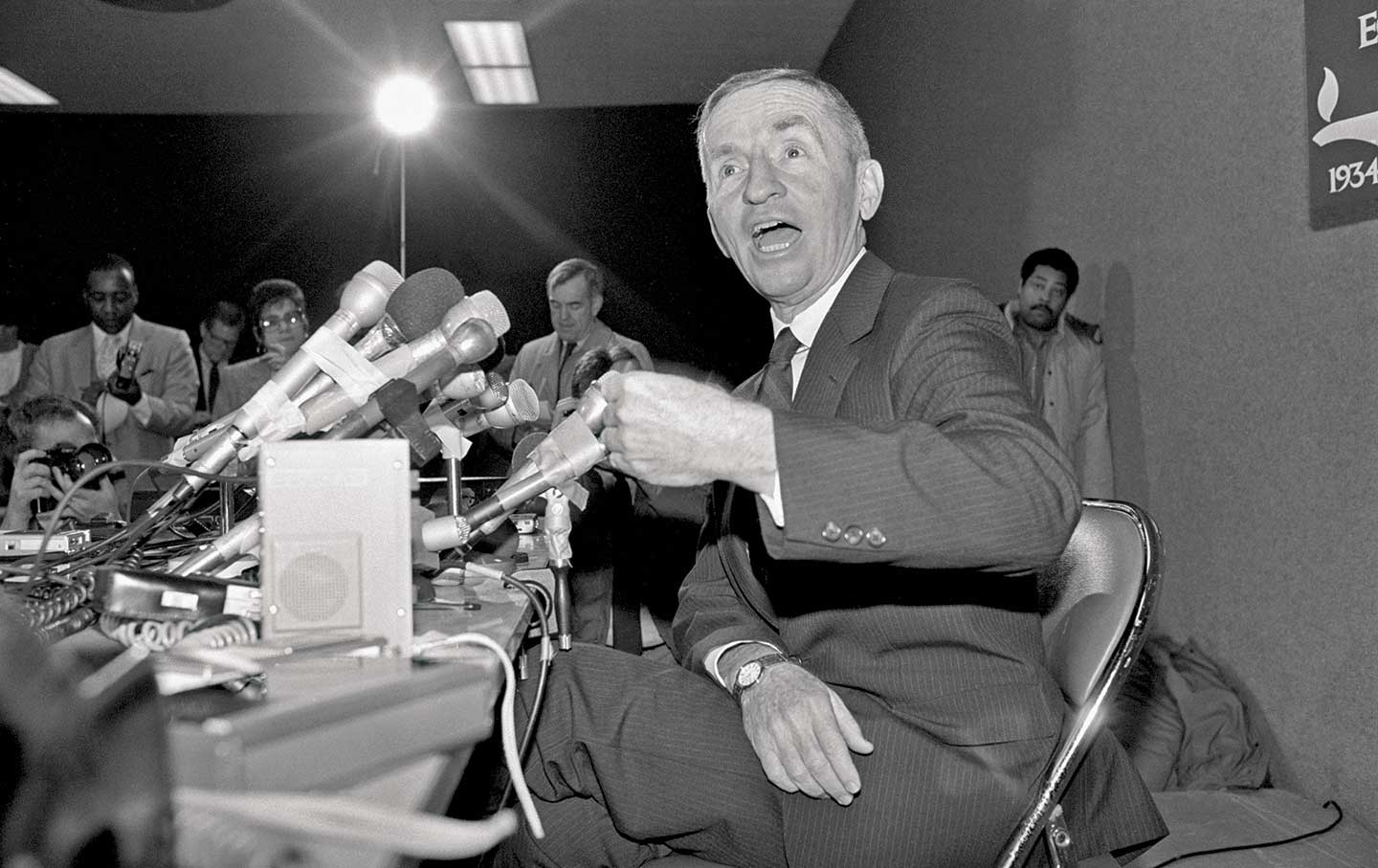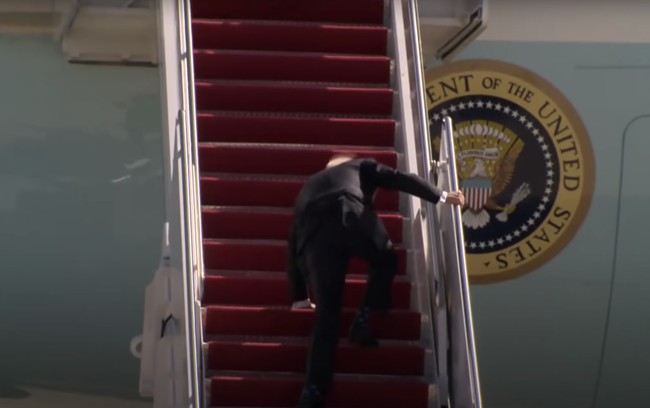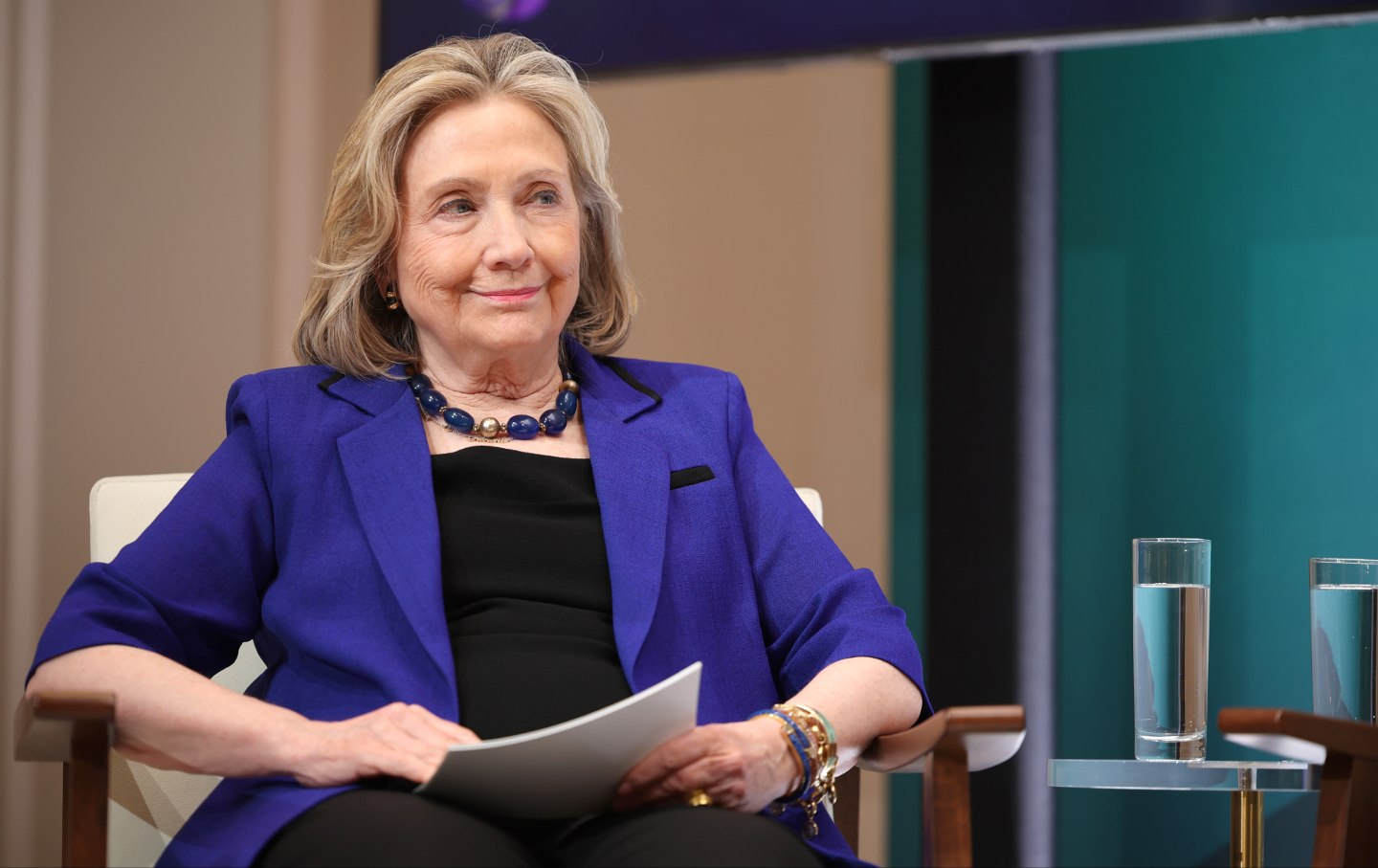Culture
/
Books & the Arts
/
July 29, 2024
In When The Clock Broke, John Ganz offers a whirlwind tour of the cranks, conservatives, and con artists who helped remake the American right at the turn of the 21st-century.
Ross Perot prior to an address to the Economic Club of Detroit.
(Getty Images)
When discussing 1989 and the years that followed, it can seem obligatory to the point of cliché to mention Francis Fukuyama’s essay “The End of History?,” published just months ahead of the fall of the Berlin Wall. Though no one, including the author, would argue that history actually ended in 1989, most everyone since then has felt compelled to reckon with Fukuyama’s central thesis: that Western liberalism and capitalism had, by the end of the 20th century, won decisively and globally over their major ideological rivals. Even 35 years later—in the wake of 9/11, the 2008 financial crisis, the rise of Donald Trump and other right-wing populists, the Covid-19 pandemic, a resurgent socialist movement in the United States, and a renewed era of great-power confrontation—it is hard to dismiss altogether Fukuyama’s claim that certain political and economic ideas have become hegemonic and are honored today even in the breach. One might debate whether these ideas are truly liberal in spirit or practice, and one can warn of emergent challenges today, but almost everyone can agree that they stood triumphant in 1989 and have dominated ever since.
Books in review
When the Clock Broke: Con Men, Conspiracists, and How America Cracked Up in the Early 1990s
Buy this book
But even at the time, Fukuyama was far more anxious than triumphalist in his avowals of a new liberal and capitalist age. He was sure that communism had been defeated, but he foresaw a looming crisis for the political and economic systems he himself championed: “In the post-historical period there will be neither art nor philosophy,” he predicted, “just the perpetual caretaking of the museum of human history.” He also feared that rising nationalism and intra-ethnic conflict—already visible at the time with the disintegration of Yugoslavia—might foil the illusory tranquility of this new world order.
These uncertainties about a liberal future sit at the center of John Ganz’s accomplished debut, When the Clock Broke: Con Men, Conspiracists, and How America Cracked Up in the Early 1990s. While many Americans in 1989 “believed they were witnessing the ultimate victory of liberal democracy,” Ganz notes, “others thought they were observing its death throes.” A whirlwind tour of the myriad right-wing insurgencies that punctuated the George H.W. Bush years, When the Clock Broke presents the post–Cold War United States not as a victorious empire but an ailing nation plagued by deindustrialization, racist militias, millenarian sects, extremist demagoguery, urban unrest, conspiracy theories, and generalized despair. If that sounds a lot like the Trump era, well, that’s precisely Ganz’s point. Trump’s election in 2016, he writes in his introduction, “represented the crystallization of elements that were still inchoate in the period of this book.” The supposedly ascendant United States at the end of history, in other words, already demonstrated all the symptoms of its present maladies.
Over the past several years, Ganz has become known as an acerbic combatant in the often internecine political debates on social media, but his considerable talents are better appreciated in his Unpopular Front newsletter, which has offered everything from nuanced commentaries on the wars in Ukraine and Gaza to deeply researched investigations into the history of France’s Third Republic. When the Clock Broke, which is an expansion of a 2018 essay Ganz wrote for The Baffler, replicates this approach. Like Unpopular Front, it showcases sophisticated political argumentation, erudite prose, enviable rigor, and a depth of knowledge.
A historian outside the academy and a political journalist without a staff job, Ganz invites comparisons to Rick Perlstein, who is thanked in the acknowledgments and whose cover blurb proclaims Ganz as “the most important young political writer of his generation.” Like Perlstein, Ganz tends to use an immersive approach to writing about the past: When the Clock Broke not only recounts but seeks to approximate the experience of living through 1989 to 1993.
Current Issue

Functioning almost as a sequel to Perlstein’s acclaimed multivolume history of the conservative movement from Barry Goldwater to Ronald Reagan, When the Clock Broke is similarly concerned with the nation’s rightward drift and wants to understand where it came from. “American democracy is often spoken of as being in peril. This book by and large agrees with this thesis,” Ganz writes. “Others point out that democracy in America never fully existed in the first place: for them, it has always been a nation enchained by great inequalities and ruled by an unrepresentative system designed largely to keep those chains in place. This book also agrees with that thesis.” In When the Clock Broke,Ganz pursues both of these arguments, emphasizing throughout not only the emerging villains but also the circumstances out of which they emerged. The origins of our times, he reminds us, have their own origins in the longue durée of American history.
In accounting for the rise of the Klansman turned congressman David Duke, for instance, Ganz feels compelled to acquaint readers with the deep roots of Louisiana history: “The alluvial plains and dense swampland of the Mississippi Delta were less like a [laboratory of democracy] than a hothouse or a petri dish of inchoate American fascism,” he writes in a characteristic passage, before briskly recounting the region’s French and Spanish colonial history, its brutal 19th-century planter class, its corrupt urban politicians, its vigilante-enforced white supremacist social order, and the boom-and-bust cycles engendered by its oil resources. Similarly, in introducing us to the Weaver family, made infamous in the 1992 Ruby Ridge shootout in Idaho, Ganz walks us through the family’s background in Iowa, in the process illustrating how shifts in technology and global commodity price fluctuations in the 1970s and ’80s drove farming communities in the Great Plains to despair—which in turn left men like Randy Weaver “even more sullen and angry, open to more radical views.”
To Ganz, we can’t know John Gotti without knowing a little about the lumpenproletariat of Naples or the social clubs of East New York; we can’t know Rush Limbaugh without a sense of what it was like to go to high school in Cape Girardeau, Missouri, in the 1960s; we can’t know Ross Perot without a grasp of how Sun Belt entrepreneurs raided Great Society spending programs to build their fortunes. Ganz’s subjects, to paraphrase Kamala Harris, didn’t just fall out of a coconut tree—they exist in the context of all that came before them (an essentially Marxist insight). If, like Ganz, you are an older millennial, you might experience When the Clock Broke as I did—as an informed adult’s reconsideration of what our parents were muttering about at the dinner table back when we were learning how to add and subtract. It’s to Ganz’s great credit that he is able to write about both wider historical trends and idiosyncratic biographical details while also keeping his story lively and amusing.
Though frequently leavened with a dry sense of humor, Ganz’s overall portrait of the United States at the end of history is a grim one. “The entire ’80s economy ran on debt: borrowed money and borrowed time,” he notes. It was the first President Bush’s misfortune, even as he claimed victory over Saddam Hussein and his approval rating soared, that the bills came due on his watch: The savings-and-loan sector collapsed in scandal, banks failed, oil prices surged, crack and homelessness flooded dilapidated inner cities, military bases closed, factory jobs moved abroad, and Brooklyn and Los Angeles exploded in race riots. The tech boom that would buoy Wall Street through the next few decades hadn’t fully begun, and the national mood was one of omnidirectional rage. It was an ideal environment for demagogues.
As concerned as he is with describing the conditions that produced these demagogues, Ganz is equally deft in characterizing their individual personalities. Duke is “caught between his desire for publicity and mainstream acceptance and his infatuation with the secretive underworld of extremism,” a doomed position neatly reflected in his pseudonymous side gig publishing pornographic literature that an aide calls “too hard-core for the right wing and too soft-core for the perverts.” Limbaugh—“a square with a flattop, he liked being the guy playing the records more than he liked the records”—is a shy introvert in person whose inner confidence emerges only in a broadcasting studio. Perot, the corporate welfare profiteer turned populist,
had one foot in the future and one in the past. On the one hand, he was a double throwback: there was all the mythological Americana, the cowboy and Western imagery, the Texas accent, the folksy idioms, the Norman Rockwells. He was also a throwback to another, more recent past, a past in contradiction with the America of self-reliance and rugged individualism but increasingly the source of its own nostalgia: the postwar regime of industrial prosperity, economic security, and corporate paternalism.
Each of these men, in his own way, is a grasping outsider thirsty for adulation and status commensurate with new money. The patrician George H.W. Bush, introduced early as a politician profoundly out of step with the times, makes for a perfect foil:
Bush did not aspire to the presidency out of a sense of political passion; his ambition was for a successful career befitting a person who was quite literally of the senatorial class: it was simply the last step in the cursus honorum of ascending offices. He had no interest in the permanent campaign of his predecessor, the “Great Communicator”: he was the representative of a class bred to govern, not to lead. Its predominance was taken for granted. He had been happiest as leader of the nation’s Super Secret Club for Privileged Boys, the Central Intelligence Agency, and he took with him the clichés and behavior of a bureaucrat: everything was a contingency, a particular case to be reacted to and then managed competently—“prudent” was one of his favorite words, as Dana Carvey’s famous Saturday Night Live send-up of the president highlighted with glee. He possessed the ditziness of the high WASPs: a love for games, toys, and practical jokes; he spoke in non sequiturs and inside or private gags. It was difficult, even for him, to know what he really meant sometimes.
No wonder, then, that Bush’s 1992 reelection campaign was “totally bereft of ideas, direction, or meaning,” thereby creating an opening for candidates who had all of the above. Though Bill Clinton is not a central focus of the book, Ganz does explore the ideas that shaped Bush’s successful Democratic challenger. Clinton, we learn, studied at Georgetown under a professor named Carroll Quigley, the author of Tragedy and Hope, a 1,300-page argument for a secular Puritanism that defended social responsibility against 1960s counterculture excesses. Quigley’s ideas peppered Clinton’s “New Covenant” campaign rhetoric and were also popular with the latter-day John Birchers who supported Perot, and who passed around bootleg copies of Tragedy and Hope at gun shows.
Pat Buchanan, who challenged Bush in the Republican primary, certainly wasn’t lacking in ideas either. In the writings of Samuel Francis and the speeches of Buchanan closely informed by them, Ganz sees the intellectual roots of what Paul Gottfried first termed “paleoconservatism,” which developed in reaction to the more cosmopolitan (read: Jewish) neoconservatism embraced by the Reagan administration. “If the neocons held up mid-century New York as the height of U.S. civilization, the paleos wanted to go much further back: to the 1920s at least, and preferably back to the nineteenth century, to the world before Lincoln and the Civil War,” Ganz writes. “The paleo aesthetic was American Gothic: white-sided Presbyterian and Congregational churches in small towns; stern, industrious folk; farmers, homesteaders, and frontiersmen.” During the Reagan years, the paleocons Russell Kirk and Joseph Sobran charged the leading neocons, Irving Kristol and Norman Podhoretz, with “dual loyalty” over their fervent support for Israel; the neocons returned fire with charges of antisemitism, while William F. Buckley made an awkward attempt to broker peace between the conservative factions. In the 1980s, these battles unfolded in the pages of small-circulation magazines like Buckley’s National Review, but in 1992 they would also play out electorally with Buchanan’s failed but damaging primary challenge to Bush, during which he articulated the case for a “new nationalism” that would “put America first”—language that would be echoed by Francis in the campaign’s wake
More from Books & the Arts
Francis, as Ganz discusses, also took a particular interest in the Mafia as an American cultural archetype—as did Murray Rothbard, another right-wing thinker that Ganz spotlights (Rothbard’s 1992 pledge, “We shall break the clock of social democracy,” inspired Ganz’s title). Both Francis and Rothbard reacted to Martin Scorsese’s Goodfellas, released in 1990, by contrasting its sordid rendering of the mob with the quasi-feudal, honor-and-loyalty-bound society portrayed in Francis Ford Coppola’s earlier Godfather films. “While The Godfather was essentially a right-wing utopia, Rothbard believed the assault on property and persons in Goodfellas reflected the actually existing liberal dystopia of street violence,” Ganz writes. Similarly, “Francis thought the famiglia in The Godfather stood for an earlier, more wholesome and integrated social form fighting to keep itself intact in an American culture that threatened to dissolve it.”
The widespread fascination with mob culture in both its idealized and debased imaginings, Ganz argues, is also the cultural context in which a real-life mob boss like Gotti could become a folk hero to many New Yorkers—to the point where Rudy Giuliani, who built his early career on prosecuting mobsters, would ultimately co-opt the style (and, years later, the criminality) of Italian American wiseguys in his bid for political office. It’s also the context in which another tough-talking vulgarian from the outer boroughs—one who did more than his share of business with mafiosi—would find a receptive national constituency on the right.
When the Clock Broke ends rather abruptly in 1993, just past Clinton’s inauguration as president after having won a mere 43 percent plurality of the popular vote (Perot won an astonishing 19 percent, the highest total any third-party candidate has received since 1912). Surveying the national landscape, Ganz gives us a sort of montage of what his antiheroes were up to at the dawn of the Clinton era. We see Perot plugging a new book inveighing against NAFTA, which Clinton would sign into law the following year with Republican support and considerable Democratic defection; we see Francis speaking at a Buchanan-affiliated event and drawing explicit inspiration from the way Adolf Hitler and the Nazis regrouped after the failed 1923 Beer Hall Putsch. Finally, Ganz checks in on Donald Trump, a recurring minor character throughout the book, who by 1993 was reeling from bankruptcies. We listen in on Trump as he meets with the aging, fascism-influenced architect Philip Johnson to discuss a potential redesign of the Trump Taj Mahal casino in Atlantic City. After listening to the future president’s inimitable bluster for a while, Johnson tells him, “You’d make a good mafioso.” To which Trump replies, “One of the greatest.”
Popular
“swipe left below to view more authors”Swipe →
It’s a hell of a kicker, and Ganz is confident enough as a writer not to feel the need to explain it any further: He trusts us to get the punch line. We already have been, and perhaps once again will be, governed by a mobster of historic proportions, albeit one more in the Goodfellas than the Godfather mode. Everything Ganz has shown us about the United States of the early 1990s—the fraying social fabric, the deregulation of talk radio, the far-right insurgency against the Republican old guard, the radicalized angry white men—would eventually culminate in the presidency of Donald Trump.
Ganz’s story is compellingly told, with a sharp eye for detail and for unexpected connections, and his implicit argument is largely persuasive, yet one might still quibble with his decision to stop where he does. Without a brief discussion at the end of what happened during the eventful 23-year gap between the end of his book and Trump’s election in 2016, the reader is left wondering why it would take another generation for the toxic political trends of the early 1990s to coalesce in their now-familiar form.
The future War on Terror, for instance, is briefly hinted at in the concluding overview of 1993, when Ganz notes that “a group known as Al-Qaeda” detonated a bomb at the World Trade Center in a vain attempt “to send one tower crashing into the other, bringing down both skyscrapers in the process. It seemed an outlandish and impossible goal: the bomb had barely damaged the building.” It’s a clever way to indicate that a lot more history is going to unfurl between then and now, but it also allows the book to avoid arguing anything more specific about that history.
To be sure, anyone reading this book is likely to recall the major developments of recent decades and would also be able to draw their own connections to the world we currently live in. Indeed, a number of well-regarded recent works of popular history have already traced the rise of Trump to the aftermath of 9/11 (Spencer Ackerman’s Reign of Terror), to the 2008 financial crisis (Adam Tooze’s Crashed), and to the racist backlash against Barack Obama’s presidency (Ta-Nehisi Coates’s We Were Eight Years in Power), to say nothing of the widely discussed failures of the Hillary Clinton campaign or the much-debated role of Russian election interference. And so it is understandable why Ganz would instead seek explanations in an era further removed from recent news cycles. Still, without a little more about how his subjects and their political projects fared during the Clinton, George W. Bush, and Obama presidencies, we are left to speculate on whether the seeds planted during the George H.W. Bush years were inevitably going to blossom into the Trump presidency, and whether there was anything that Americans might have done in the interregnum to avoid that outcome.
As we confront a potential Trump restoration, this question isn’t merely academic. As Ganz convincingly demonstrates, Trump represents a constellation of reactionary forces that emerged at the supposed end of history—but history never ends, and what comes next is up to us.
Thank you for reading The Nation
We hope you enjoyed the story you just read, just one of the many incisive, deeply-reported articles we publish daily. Now more than ever, we need fearless journalism that shifts the needle on important issues, uncovers malfeasance and corruption, and uplifts voices and perspectives that often go unheard in mainstream media.
Throughout this critical election year and a time of media austerity and renewed campus activism and rising labor organizing, independent journalism that gets to the heart of the matter is more critical than ever before. Donate right now and help us hold the powerful accountable, shine a light on issues that would otherwise be swept under the rug, and build a more just and equitable future.
For nearly 160 years, The Nation has stood for truth, justice, and moral clarity. As a reader-supported publication, we are not beholden to the whims of advertisers or a corporate owner. But it does take financial resources to report on stories that may take weeks or months to properly investigate, thoroughly edit and fact-check articles, and get our stories into the hands of readers.
Donate today and stand with us for a better future. Thank you for being a supporter of independent journalism.
More from The Nation
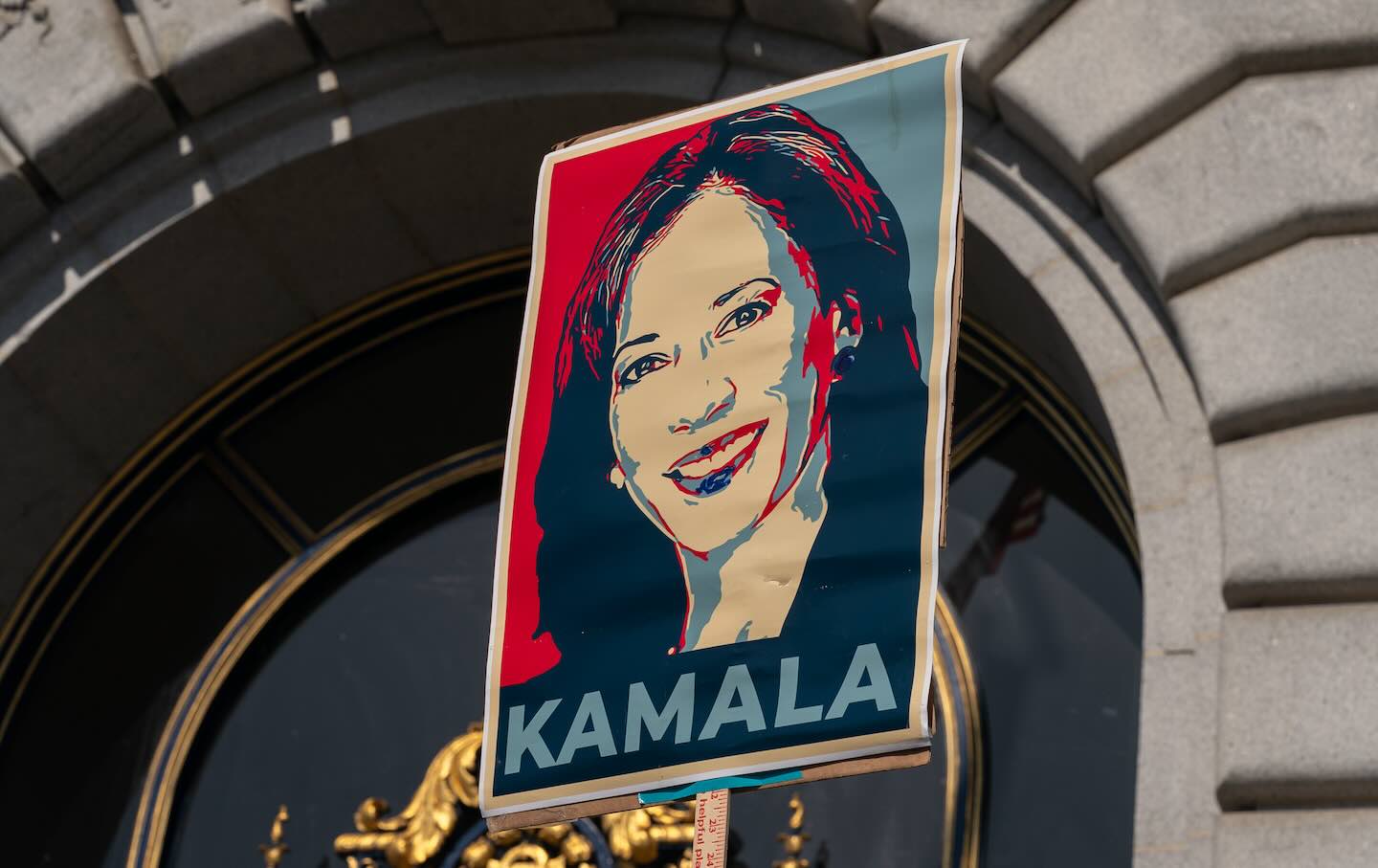
The nomination gives the presumptive Democratic presidential nominee a second ballot line in New York and a big organizational boost from WFP and its allies.
John Nichols
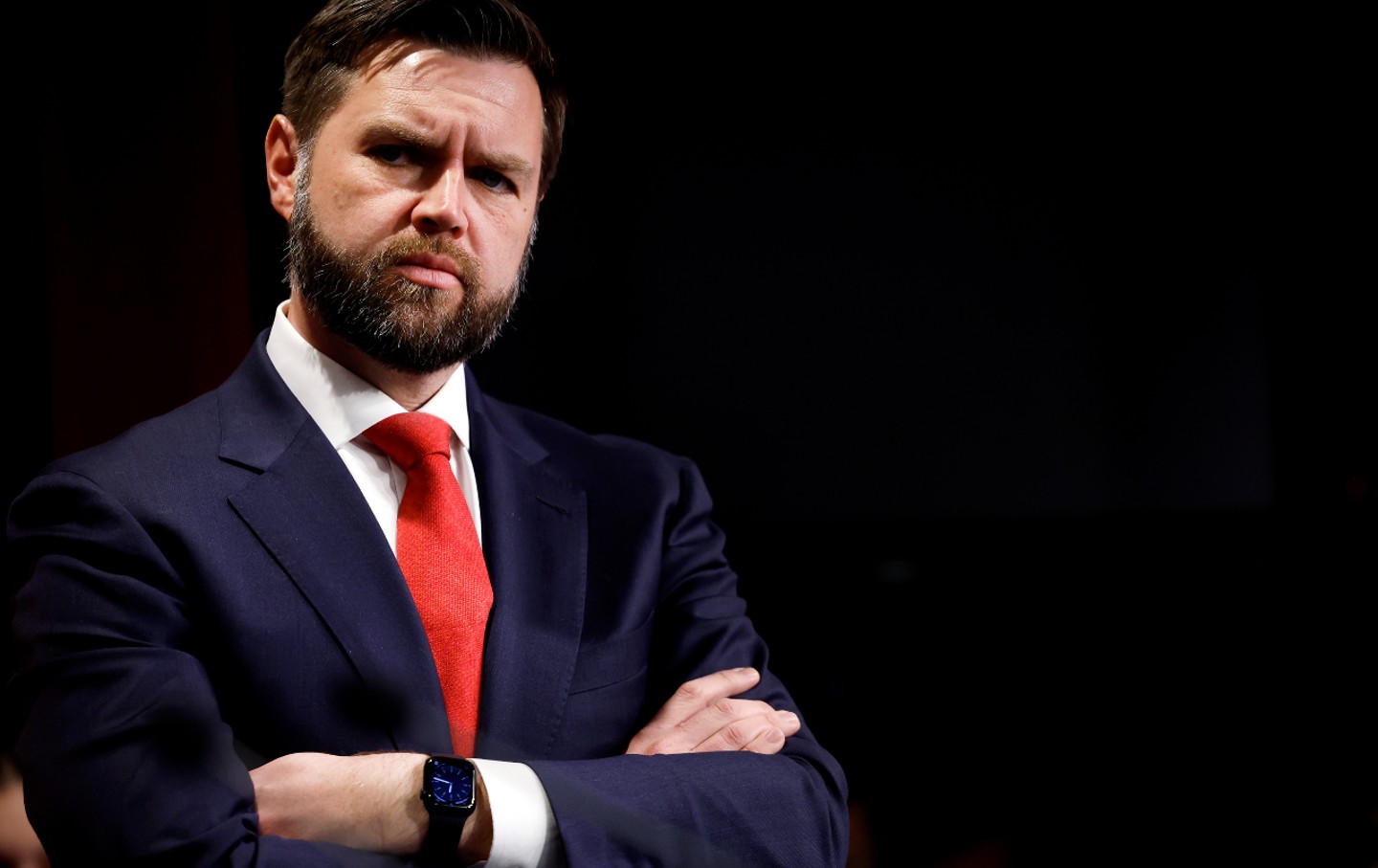
Patriarchy, plutocracy, and ethnonationalism fuel the vice-presidential candidate’s bizarre slur.
Jeet Heer
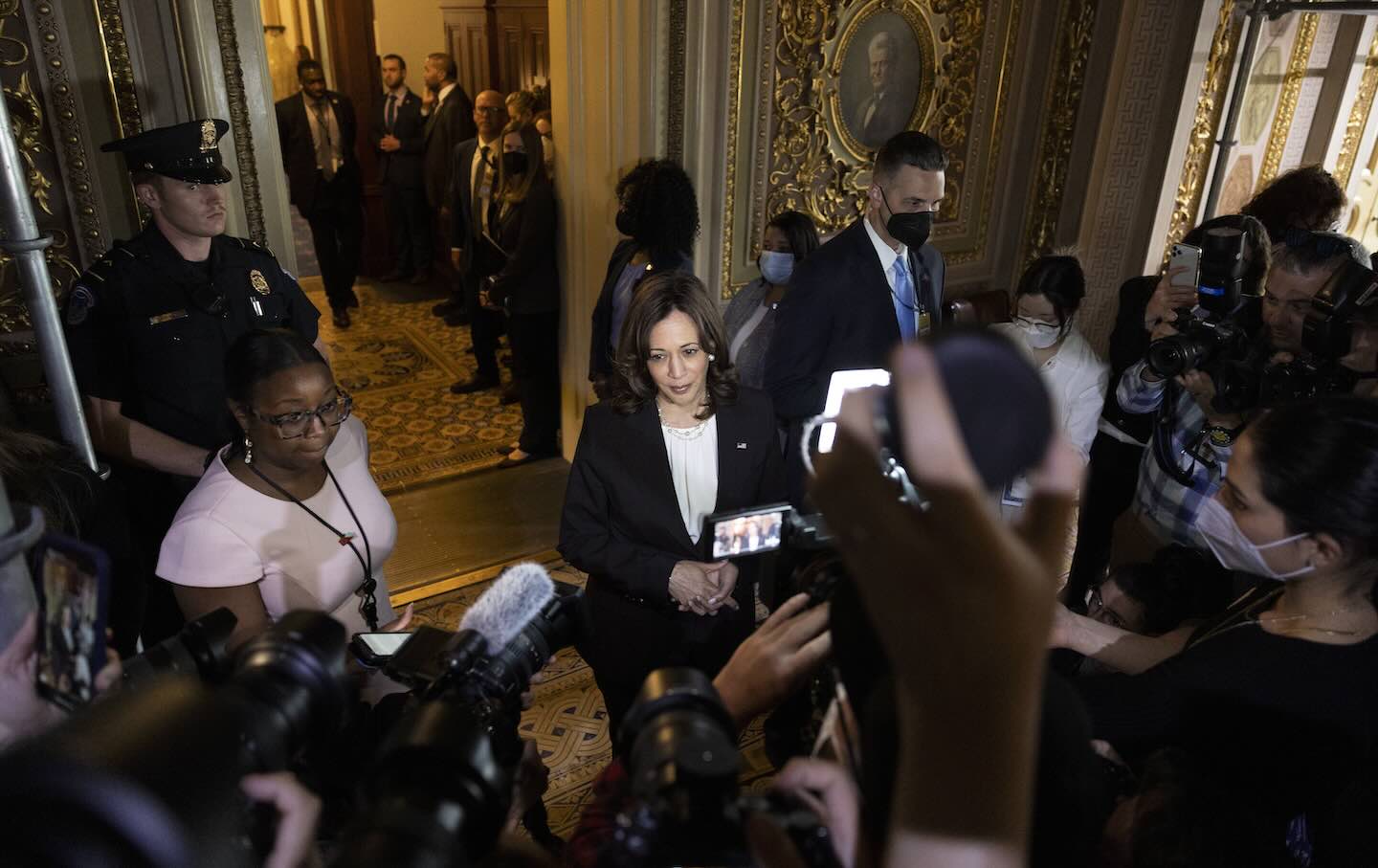
Since her time as California attorney general, Vice President Kamala Harris has proven to be a tough-as-nails negotiator.
Sasha Abramsky
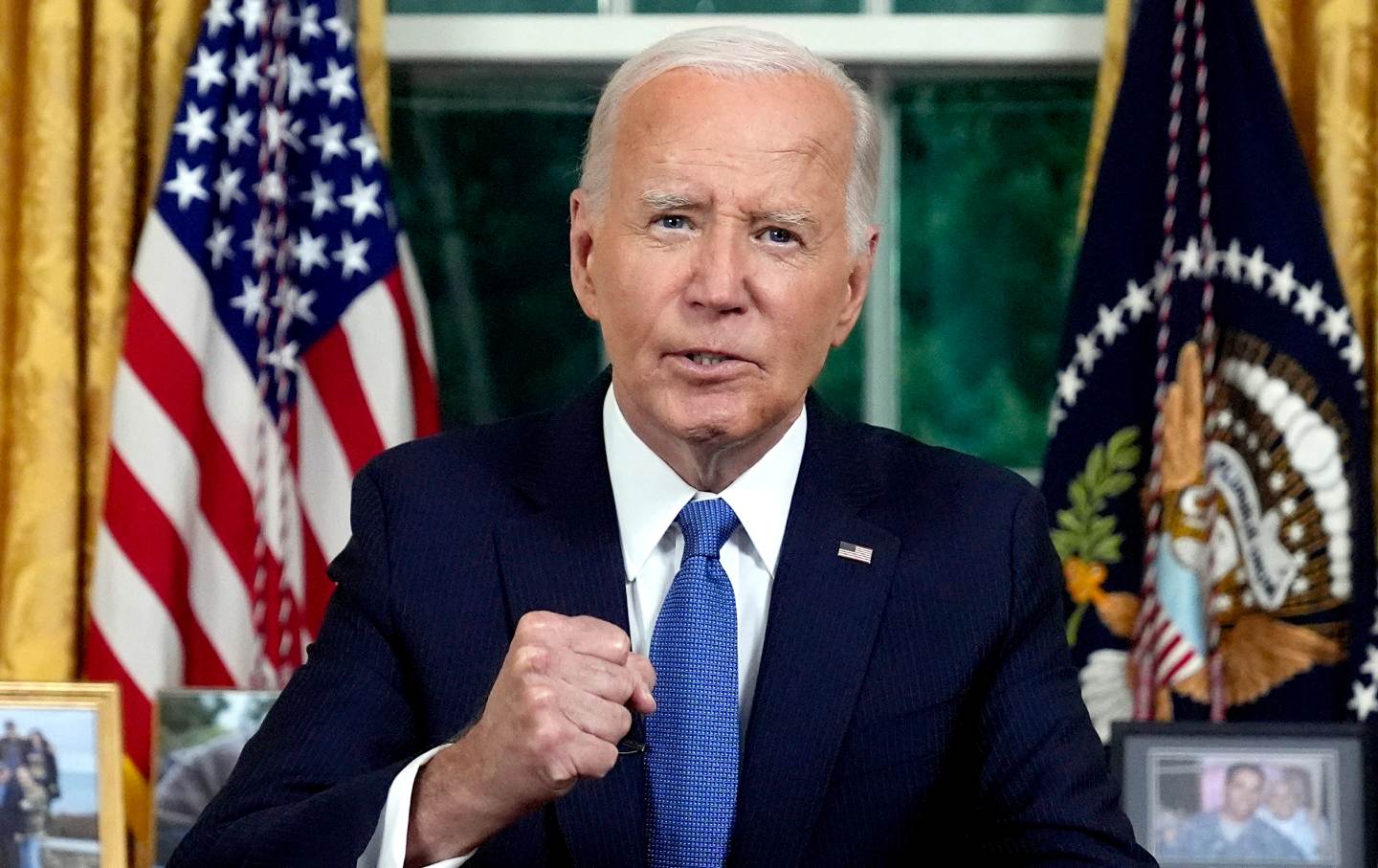
Wednesday night’s address was moving, and also confirmed that he’d made the right decision.
Joan Walsh
